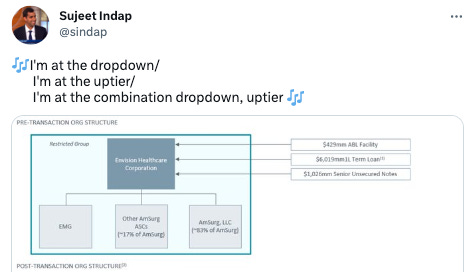💥"Position Enhancing Transactions"💥
Envision Healthcare, Serta Simmons, Cox Oil, LifeSize Inc., Virgin Orbit + More
A few months back, Jones Day’s Bruce Bennett offered a theory to explain the recent emergence of aggressive borrower behavior.1 He highlighted that, before the Great Financial Crisis (“GFC”), banks held substantial exposure to leveraged loans on their balance sheets. Relationship banking, therefore, actually meant something; it meant something to the bankers who wanted the fees; and it meant something to the PE firms who needed leverage to juice returns on their investments/buyouts. The borrowers themselves may change from deal to deal but the sponsors and bankers were repeat players. Any urge to take aggressive action by Portfolio Managers or their borrower portcos to the detriment of lenders typically got quashed by the higher-ups out of concern for the next deal: no sense complicating future financings.
But post-GFC, all that sh*t kind of went out the window. Now regulated AF, banks began selling off their exposure to a dispersed mix of funds and CLOs. PE shops became behemoths backed by gobs and gobs of cash and started to give fewer and fewer f*cks about who they stepped on. And with their sponsors’ buy-in, PE-backed borrowers suddenly had far less compunction over engaging in chicanery at their lenders’ expense.
Cue the rise of “liability management exchanges” (“LMEs”) or “liability management transactions” (“LMTs”) or, as Judge Jones put it this week, “position-enhancing transactions” or PETs. “And it doesn’t really matter whether you have a cat or dog — the results are the same,” he said, referring to dropdowns and uptiers and the fact that both sorts of transactions (not to mention paired exchanges) seem to end up (i) in bankruptcy anyway (ii) with the non-participating lenders in both scenarios on the receiving end of a fist up the arse (read: piss poor outcomes/recoveries).
Boiled down to their simplest form LMEs/LMTs/PETs, are all about “option value” and building “runway.” To the eternally optimistic PE sponsor, every flailing portfolio company is *just around the corner* from positive cash-flow (as are, gulp, lower interest rates?). If there’s the possibility of joining forces with a borrower and a certain subset of lenders to the detriment of others — and that possibility provides a liquidity runway that simultaneously provides management time to play out a new business plan accretive to the investment — why not play out that option? The alternative is a bankruptcy where only the restructuring professionals win. The risk is that the left-out lenders will sue. Clearly the borrowers, the sponsors, and the participating lenders in all of these situations we’ve been talking about for years now — whether it’s J.Crew or Revlon or Serta — decided the risk was worth it. And they’re not wrong. In each instance, the option didn’t play out as hoped, but the borrowers and sponsors ended up in basically the same place and the participating lenders, even when sued, ended up better off (thanks, in large part, to highly accommodative bankruptcy judges). Hence why these kinds of transactions — and the bankruptcies that follow — aren’t going away anytime soon2….
💥Envisioning a Violent Future💥
On May 15th 2023, TN-based and KKR-backed Envision Healthcare Corp. and 216(!!) affiliates (the “debtors”) filed for chapter 11 bankruptcy in the Southern District of Texas (Judge Lopez). As with most PE bankruptcies, there are two distinct stories here. First, what happened to the underlying business? And, second, what sort of capital structure weirdness are we dealing with? Let’s dig in ⬇️.




